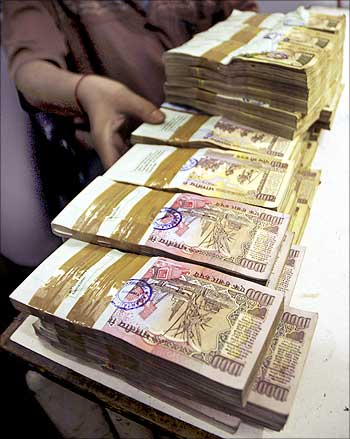 With the introduction of polymer notes, the government aims at ending the menace of counterfeit currency in the next five years, reports Vicky Nanjappa
With the introduction of polymer notes, the government aims at ending the menace of counterfeit currency in the next five years, reports Vicky Nanjappa
In yet another bid to fight the menace of counterfeit currency in India, the government has decided to introduce one billion pieces of the Rs 10 bank notes made of plastic on a trial basis. After the trial period, the denomination of the plastic notes will be increased as a permanent solution to counter the fake currency racket.
If the trial process is smooth sailing, then the government will introduce plastic or polymer notes in higher denominations. The biggest problem that the government faces today is from the Rs 500 notes.
Will plastic currency be able to fight counterfeit ones? Plastic notes have been introduced in Australia, New Zealand, Papua New Guinea, Romania, Bermuda, Brunei and Vietnam. While they have been effective in these countries, the Indian government will have to take into account other aspects before deciding on the feasibility of such notes. Plastic notes have a five-year lifetime. Moreover, the environmental concerns of such currency will also have to be considered.
But insiders say that the government is keen on going ahead with this new project since the menace of fake currency has spun out of control. Currently, the value of the fake currency in the market is a staggering Rs 120,000,000,000,000 (Rs 12 lakh crore). It is virtually impossible for the agencies to detect every note and take it out of the market.
Keeping in mind the situation it is best to change the nature of the currency, said experts. Firstly, the cost of printing plastic notes will be high and a counterfeiter will think twice before making such an investment. Once the lifespan of these notes ends new ones would need to be printed and the ones floating in the marked would lose their value.
The other benefits of plastic notes are listed below:
When notes are printed on plastic or polymer, it becomes easier to recognise a counterfeit. Making a fake note out of this material is not only time consuming, but very costly. It also gives the government an option to add enhanced security measures from time to time due to the expiry dates these notes come with.
Indian officials say that plastic notes have worked like a charm in Australia and hence it would here too. In Australia, it was introduced for a four-year period between 1992 and 1996. During this period the Australian government only found 26 fake notes ($20 denominations).
During the investigation of these notes, it was found that fake currency could be easily detected. The first visible difference was the thickness of the notes. Secondly, it was found that there was crude embossing in the clear window. Thirdly, the sound on flicking the note was different, as the counterfeiter had used a cheaper polymer substrate.
Indian officials say that they would like to keep plastic notes in circulation for at least five years. This would help get rid of the fake notes in the market.
“May be the counterfeiter would try to replicate the plastic notes. However, in our experience they are bound to get it wrong in the first couple of years. By the time they master it technique, we will be ready with our next design and enhanced security options. We expect that the menace of fake currency would vanish in another three to five four years,” a source in the financial unit of the Intelligence Bureau pointed out.
”Also, we have found that plastic notes are more durable in nature. We can recycle the product and hence there will not be any environmental issues,” the officer added.









